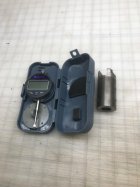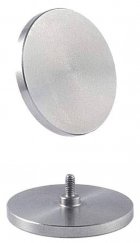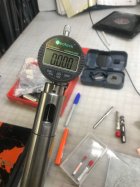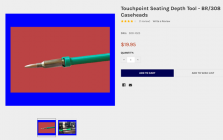Install the app
How to install the app on iOS
Follow along with the video below to see how to install our site as a web app on your home screen.
Note: This feature may not be available in some browsers.
You are using an out of date browser. It may not display this or other websites correctly.
You should upgrade or use an alternative browser.
You should upgrade or use an alternative browser.
Finding the lands...Tool!
- Thread starter gunsandgunsmithing
- Start date
That is true but not as bad as it sounds because a bbl has to be off before it gets installed the first time. Granted, it would need to come off after that but that initial measure is very useful to establish a base setting. From there, I've simply tuned back up by moving the bullet out .003 at a time, without the tool. I mean, I know how far I moved it before it tuned back in as well as my base setting. So, it still gives valuable info even if it's only used on a fresh bbl. Just my thinking but aside from that, it's also a handy tool when chambering a bbl with the old bbl in-hand for both headspace and cone/breech depths. I use it all the time for that, virtually. One other thing it's good for is setting shoulder bump, if the bbl is off or with a bbl stub or old bbl that has at least the shoulder portion of the chamber. Like that, the stub or old bbl just becomes a comparator body for the tool.Downside is the barrel has to be off the action.
I'll just say..IMO, it is a handy tool to have and stop there. Thanks
FNSafari
Gold $$ Contributor
All correct, but I still prefer alex wheelers method of finding the lands then proceeding from there. You have tuners in stock?? Send me a PM with price and shipping please.That is true but not as bad as it sounds because a bbl has to be off before it gets installed the first time. Granted, it would need to come off after that but that initial measure is very useful to establish a base setting. From there, I've simply tuned back up by moving the bullet out .003 at a time, without the tool. I mean, I know how far I moved it before it tuned back in as well as my base setting. So, it still gives valuable info even if it's only used on a fresh bbl. Just my thinking but aside from that, it's also a handy tool when chambering a bbl with the old bbl in-hand for both headspace and cone/breech depths. I use it all the time for that, virtually. One other thing it's good for is setting shoulder bump, if the bbl is off or with a bbl stub or old bbl that has at least the shoulder portion of the chamber. Like that, the stub or old bbl just becomes a comparator body for the tool.
I'll just say..IMO, it is a handy tool to have and stop there. Thanks
PM sent.All correct, but I still prefer alex wheelers method of finding the lands then proceeding from there. You have tuners in stock?? Send me a PM with price and shipping please.
I think both ways are good but either way, ya gotta take something apart. Ya either strip the bolt with his method, or pull the bbl with this.
dusterdave173
Silver $$ Contributor
I have used several methods over the years--and I have learned and gained more experience I think I am better at finding "it" but I have a question--
Folks seem obsessed with getting it dead on and I have always thought that it is just a reference point right? I mean if I get it wrong them maybe my load likes .040 Out vs >010 out if I had got it dead nuts correct--I just can't see what difference it would make--I am just using it as a point of reference. Then maybe it is In or Out for best results from that point but what difference could it make? Once I "name" a point as it--- I work from there to find best grouping depth and my results have been great
It can be very tedious to nail it --I just repeat until I start getting pretty close to the same number then usually round it off for easy math from there I mean if it is 1.817 I just call it 1.815 or better yet 1.820 and never look back
Folks seem obsessed with getting it dead on and I have always thought that it is just a reference point right? I mean if I get it wrong them maybe my load likes .040 Out vs >010 out if I had got it dead nuts correct--I just can't see what difference it would make--I am just using it as a point of reference. Then maybe it is In or Out for best results from that point but what difference could it make? Once I "name" a point as it--- I work from there to find best grouping depth and my results have been great
It can be very tedious to nail it --I just repeat until I start getting pretty close to the same number then usually round it off for easy math from there I mean if it is 1.817 I just call it 1.815 or better yet 1.820 and never look back
I don't disagree at all. It seems lots of people prefer to work from some kind of number. In fact, I only used mine for bbl chambering for the longest time...until it dawned on me that it had other uses, with minor mods to the one I made probably 25 years ago, or whatever it was now.I have used several methods over the years--and I have learned and gained more experience I think I am better at finding "it" but I have a question--
Folks seem obsessed with getting it dead on and I have always thought that it is just a reference point right? I mean if I get it wrong them maybe my load likes .040 Out vs >010 out if I had got it dead nuts correct--I just can't see what difference it would make--I am just using it as a point of reference. Then maybe it is In or Out for best results from that point but what difference could it make? Once I "name" a point as it--- I work from there to find best grouping depth and my results have been great
It can be very tedious to nail it --I just repeat until I start getting pretty close to the same number then usually round it off for easy math from there I mean if it is 1.817 I just call it 1.815 or better yet 1.820 and never look back
ExactlyThe most simple answer is usually the best answer. Lots of back-n-forth out there about "the best way" to find the lands but they're all equally clunky in my opinion. I like how slick this is. I'll be making one.
urbanrifleman
Site $$ Sponsor
That is true but not as bad as it sounds because a bbl has to be off before it gets installed the first time. Granted, it would need to come off after that but that initial measure is very useful to establish a base setting. From there, I've simply tuned back up by moving the bullet out .003 at a time, without the tool. I mean, I know how far I moved it before it tuned back in as well as my base setting. So, it still gives valuable info even if it's only used on a fresh bbl. Just my thinking but aside from that, it's also a handy tool when chambering a bbl with the old bbl in-hand for both headspace and cone/breech depths. I use it all the time for that, virtually. One other thing it's good for is setting shoulder bump, if the bbl is off or with a bbl stub or old bbl that has at least the shoulder portion of the chamber. Like that, the stub or old bbl just becomes a comparator body for the tool.
I'll just say..IMO, it is a handy tool to have and stop there. Thanks
I think it is a great idea. How do you measure cone depth with this?
Yep, thisWith a known datum and one of these turned to that datum possibly, or a ball bearing and some math.
View attachment 1676000
urbanrifleman
Site $$ Sponsor
Yep, this
I have seen the ball bearing method. So, I guess You use a ball bearing basically the same size as the ID of the tool so I mostly self centers.
Nah, the tool for cones is a little different than the one in the video in that, I mill two slots that allow it some adjustability over varying thread od's, like..1.058-1.062. It could be fancier but a hose clamp is very functional for this. The idea being that you just want a very close slip fit over the tenon so that it centers up and stays there. The large flat tip just establishes a datum on the cone that gets transferred to the new cone when ya cut it. It just lets ta copy the old cone depth so if it was wrong before, it'll be wrong again. If it was right before, it should be right again, too.I have seen the ball bearing method. So, I guess You use a ball bearing basically the same size as the ID of the tool so I mostly self centers.
I've been returning messages and calls but the revival of this thread had my message box pretty busy. If I missed ya, let me know. Thanks--Mike
Probably not the best way but this has worked for me, on neck turned barrels, where my hornady comparator and brass won’t fit. I turn necks and then run a mandrel with 1000 neck tension, seat a bullet long (no primer or powder) and when you cam the action closed it seats the bullet on the lands. I haven’t had a bullet get stuck as the neck tension has been enough to pull the round out without it moving.. Later if I want to seat past Jam I just use heavier neck tension or work back from seated jam. I found plenty of good loads right where the cam action seats the bullet. Your mileage may vary, try it, it won’t hurt anything as the bullet hitting the lands and the thrust on the bolt is significantly more when fired…my simple two cents. PS - everyone who seats past jam is likely doing this anyways
Want2BS8ed
Michael Dunn
Mike,I've been returning messages and calls but the revival of this thread had my message box pretty busy. If I missed ya, let me know. Thanks--Mike
Sent you a DM.
Thanks,
Mike
Here is a tool you can get from PMA that a friend of mine developed. It basically works with the same principal of how Speedy shows how to find touch but you can do it with the barrel still in the action. It's about 8" long and I normally use it with the rifle standing straight up but can be used with the rifle in the cradle as well. You just load a dummy round long and try it in the chamber and keep seating the bullet deeper until you find the exact spot where the bullet doesn't "Stick" It comes in handy when your at a match and want to find or confirm a seating depth and don't want to have to strip down a bolt.
Attachments
Similar threads
- Replies
- 54
- Views
- 5,525
- Replies
- 9
- Views
- 1,109
Upgrades & Donations
This Forum's expenses are primarily paid by member contributions. You can upgrade your Forum membership in seconds. Gold and Silver members get unlimited FREE classifieds for one year. Gold members can upload custom avatars.

Click Upgrade Membership Button ABOVE to get Gold or Silver Status.
You can also donate any amount, large or small, with the button below. Include your Forum Name in the PayPal Notes field.
To DONATE by CHECK, or make a recurring donation, CLICK HERE to learn how.

Click Upgrade Membership Button ABOVE to get Gold or Silver Status.
You can also donate any amount, large or small, with the button below. Include your Forum Name in the PayPal Notes field.
To DONATE by CHECK, or make a recurring donation, CLICK HERE to learn how.













